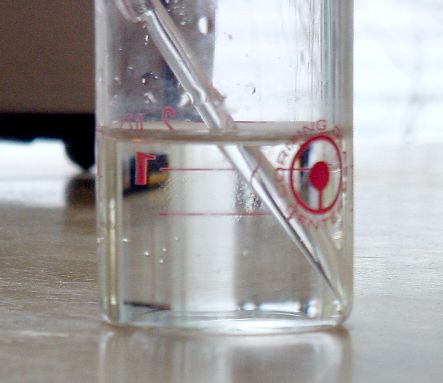I wanted to make glass disappear in a liquid . I was just browsing about it and found the way.This simple video shows how the glass gets disappeared inside the liquid.
Step 1:
Get a glass rod made from pyrex. This was the hardest part. I got one from the high school chemistry department. Using hollow glass objects like test tubes and pipets and eye-droppers isn't as impressive. The double wall nature of these objects makes it more than twice as hard to make the object disappear. Plus having a glass rod results in a simple test to see if your liquid's index of refraction is too high or too low (explained below in step 4). Pyrex has a low IOR compared to other glasses. Fortunately it is a very common glass. Most glass blown decorations are also pyrex so you could try one of those if you have one.
Step 2:
Pick two liquids that can be mixed together . One with an index of refraction higher than glass and one lower.Baby Oil's IOR is slightly lower than glass. Oil is slightly higher.You only have to mix for 10-30 seconds before testing. It requires 1 to 3 minutes each time you add a drop of water. Also it gets bubbles in it easily and they take 30-60 minutes to reach the surface and pop.
Step 3:
Next is to find a suitable transparent container and put a horizontal line on it or behind it for testing purposes.
Step 4:
Testing! Put your liquid in your container, insert glass rod. Hold rod vertically and tilt it to the left or the right. If the horizontal line tilts in the same direction, then the index of refraction of the liquid is too low. Water is a good example of this. Here is a picture with water - note that the red line is angled roughly twice that of the rod but in the same direction. If the line tilts in the opposite direction your IOR is too high. As you get close, the tilt is very subtle and you have to look at the edges, tilt the rod more, or hold the rod farther from the horizontal line (towards the front of the container).
Step 5:
Mixing - obviously steps 4 and 5 are repeated alot to get it perfect.If you add too much water (easy to do) and your container is getting too full, put this mixture aside and use it instead of water next time. The mixing goes much faster because the difference in IOR between the two liquids isn't as dramatic.
TEMPERATURE! - I've read that temperature will affect IOR so make sure you do your testing with the liquids at room temperature or at the temperature which they will be used. This goes for your glass also.




0 comments:
Post a Comment